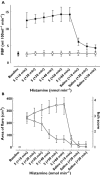Histamine-induced vasodilatation in the human forearm vasculature
- PMID: 23488545
- PMCID: PMC3853529
- DOI: 10.1111/bcp.12110
Histamine-induced vasodilatation in the human forearm vasculature
Abstract
Aim: To investigate the mechanism of action of intra-arterial histamine in the human forearm vasculature.
Methods: Three studies were conducted to assess changes in forearm blood flow (FBF) using venous occlusion plethysmography in response to intra-brachial histamine. First, the dose-response was investigated by assessing FBF throughout a dose-escalating histamine infusion. Next, histamine was infused at a constant dose to assess acute tolerance. Finally, a four way, double-blind, randomized, placebo-controlled crossover study was conducted to assess FBF response to histamine in the presence of H1 - and H2 -receptor antagonists. Flare and itch were assessed in all studies.
Results: Histamine caused a dose-dependent increase in FBF, greatest with the highest dose (30 nmol min(-1) ) infused [mean (SEM) infused arm vs. control: 26.8 (5.3) vs. 2.6 ml min(-1) 100 ml(-1) ; P < 0.0001]. Dose-dependent flare and itch were demonstrated. Acute tolerance was not observed, with an increased FBF persisting throughout the infusion period. H2 -receptor antagonism significantly reduced FBF (mean (95% CI) difference from placebo at 30 nmol min(-1) histamine: -11.9 ml min(-1) 100 ml(-1) (-4.0, -19.8), P < 0.0001) and flare (mean (95% CI) difference from placebo: -403.7 cm(2) (-231.4, 576.0), P < 0.0001). No reduction in FBF or flare was observed in response to the H1 -receptor antagonist. Itch was unaffected by the treatments. Histamine did not stimulate vascular release of tissue plasminogen activator or von Willebrand factor.
Conclusion: Histamine causes dose-dependent vasodilatation, flare and itch in the human forearm. H2 -receptors are important in this process. Our results support further exploration of combined H1 - and H2 -receptor antagonist therapy in acute allergic syndromes.
Keywords: forearm blood flow; histamine; vasodilatation; venous occlusion plethysmography.
© 2013 The Authors. British Journal of Clinical Pharmacology © 2013 The British Pharmacological Society.
Figures



 placebo;
placebo;  H1-receptor antagonist;
H1-receptor antagonist;  H2-receptor antagonist;
H2-receptor antagonist;  H1- and H2-receptor antagonist
H1- and H2-receptor antagonistSimilar articles
-
Morphine is an arteriolar vasodilator in man.Br J Clin Pharmacol. 2009 Apr;67(4):386-93. doi: 10.1111/j.1365-2125.2009.03364.x. Br J Clin Pharmacol. 2009. PMID: 19371311 Free PMC article. Clinical Trial.
-
Calcitonin gene-related peptide-induced vasodilation in the human forearm is antagonized by CGRP8-37: evaluation of a human in vivo pharmacodynamic model.Clin Pharmacol Ther. 2006 Mar;79(3):263-73. doi: 10.1016/j.clpt.2005.11.005. Epub 2006 Feb 7. Clin Pharmacol Ther. 2006. PMID: 16513450 Clinical Trial.
-
Moderate, Short-Term, Local Hyperglycemia Attenuates Forearm Endothelium-Dependent Vasodilation After Transient Ischemia-Reperfusion in Human Volunteers.J Cardiothorac Vasc Anesth. 2017 Oct;31(5):1649-1655. doi: 10.1053/j.jvca.2016.11.040. Epub 2016 Dec 2. J Cardiothorac Vasc Anesth. 2017. PMID: 28284926 Clinical Trial.
-
Reproducibility of forearm vasodilator response to intra-arterial infusion of calcitonin gene-related peptide assessed by venous occlusion plethysmography.Br J Clin Pharmacol. 2005 Apr;59(4):387-97. doi: 10.1111/j.1365-2125.2005.02333.x. Br J Clin Pharmacol. 2005. PMID: 15801933 Free PMC article.
-
Characterization and distribution of histamine H1- and H2-receptors in precapillary vessels.J Cardiovasc Pharmacol. 1984;6 Suppl 4:S587-97. doi: 10.1097/00005344-198406004-00005. J Cardiovasc Pharmacol. 1984. PMID: 6083401 Review.
Cited by
-
Tocilizumab-induced anaphylaxis in patients with adult-onset Still's disease and systemic juvenile idiopathic arthritis: a case-based review.Rheumatol Int. 2020 May;40(5):791-798. doi: 10.1007/s00296-019-04456-9. Epub 2019 Oct 9. Rheumatol Int. 2020. PMID: 31598752 Review.
-
Effect of histamine-receptor antagonism on leg blood flow during exercise.J Appl Physiol (1985). 2020 Jun 1;128(6):1626-1634. doi: 10.1152/japplphysiol.00689.2019. Epub 2020 May 14. J Appl Physiol (1985). 2020. PMID: 32407239 Free PMC article.
-
Histamine H2-receptor antagonism improves conduit artery endothelial function and reduces plasma aldosterone level without lowering arterial blood pressure in angiotensin II-hypertensive mice.Pflugers Arch. 2024 Mar;476(3):307-321. doi: 10.1007/s00424-024-02909-0. Epub 2024 Jan 27. Pflugers Arch. 2024. PMID: 38279994 Free PMC article.
-
Ipsilateral somatic nerves mediate histamine-induced vasosensory reflex responses involving perivascular afferents in rat models.Sci Rep. 2021 Jul 19;11(1):14648. doi: 10.1038/s41598-021-94110-x. Sci Rep. 2021. PMID: 34282171 Free PMC article.
-
Untargeted metabolomics for uncovering biological markers of human skeletal muscle ageing.Aging (Albany NY). 2020 Jun 24;12(13):12517-12533. doi: 10.18632/aging.103513. Epub 2020 Jun 24. Aging (Albany NY). 2020. PMID: 32580166 Free PMC article.
References
-
- Sampson HA, Munoz-Furlong A, Campbell RL, Adkinson NF, Jr, Bock SA, Branum A, Brown SGA, Carmago CA, Cydulka R, Galli SJ, Gidudu J, Gruchalla RS, Harlor AD, Hepner DL, Lewis LM, Liebermen PL, Metcalfe DD, O'Conner R, Muraro A, Rudman A, Schmitt C, Scherrer D, Simons FER, Thomas S, Wood JP, Decker WW. Second symposium on the definition and management of anaphylaxis: summary report – Second National Institute of Allergy and Infectious Disease/Food Allergy and Anaphylaxis Network symposium. J Allergy Clin Immunol. 2006;117:391–397. - PubMed
-
- Bateman DN, Woodhouse KW, Rawlins MD. Adverse reactions to N-acetylcysteine. Hum Toxicol. 1984;3:393–398. - PubMed
-
- Waring WS, Stephen AF, Robinson OD, Dow MA, Pettie JM. Lower incidence of anaphylactoid reactions to N-acetylcysteine in patients with high acetaminophen concentrations after overdose. Clin Toxicol (Phila) 2008;46:496–500. - PubMed
-
- Simons FE. Advances in H1-antihistamines. N Engl J Med. 2004;351:2203–2217. - PubMed
-
- MacGlashan D., Jr Histamine: a mediator of inflammation. J Allergy Clin Immunol. 2003;112(4 Suppl):S53–59. - PubMed
Publication types
MeSH terms
Substances
Grants and funding
LinkOut - more resources
Full Text Sources
Other Literature Sources
Research Materials
Miscellaneous

